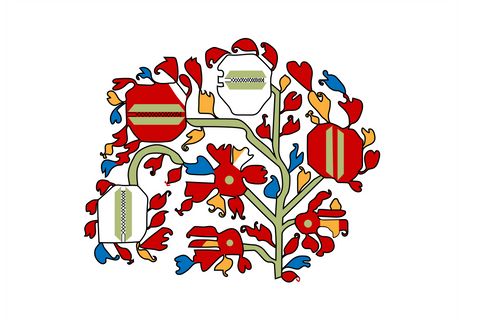Tree of Life

The tree of life is the oldest archaic ornament also known as the sacred tree. According to the mythological beliefs of the Slavs, the roots of this tree entwine the whole earth, and its branches cover the sky. The cult of motherhood and fertility is also closely connected with this tree.
Science derives the tree of life from Babylonian-Assyrian art, whence it spread throughout the whole of anterior Asia. Since the 5th century, the image of the date palm has decorated the mosaic images of New Testament persons and events. The oldest images are known from the 7th century BC, where the naturalistic depiction seems to be earlier than the stylized one. Over time, the motif of the sacred tree appeared in Persian, Egyptian, Aegean-Minoan, Greek and Roman art. The popularity of the sacred tree also carried over into Christian art, imbued with new conceptual content on the basis of the paradise tree. Thus the tree of life becomes universal in scope. The main conductor of this motto was the Persians.
The Hellenistic style represents the palm tree with two parts - a thin tall stem and a crown, or below two branches drawn artificially to the side, or two birds, or a scene of hunting beasts with two horsemen, two peacocks, etc. The sacred tree appears, in all probability, not as a real plot, but as a kind of Eastern talisman. Later, this motif degenerated into a stylized tree or flower, with lions, vultures and birds symmetrically placed on its two sides. However, this type has had endless variations and undergone many changes. Bulgarian embroidering art has preserved the ancient motif of the sacred tree mainly in embroidering on the skirts of women's shirts and cloths, mostly in Ikhtiman, Samokovo and Stankedimitrov. Because this ancient ornament was imported to us without its symbolic meaning, the embroiderer also transformed it in her mind according to the local domestic situation.
While in church ornamentation the symmetrically opposite peacocks peck a pear fruit, in Ikhtiman, where fruit growing is well developed, the needlewoman breaks the mara in her mind like an apple, so that the whole ornamental composition receives the typical expression according to the Ikhtiman dialect: "Two chickens peck enu yabuku" (Two chickens peck an apple). In Samokov, the ancient idea of horse heads still lives in the minds of knitters and, traditionally, peacocks transformed from horse heads still bear the name "horses", and the Persian palm has been transformed into a pine, which is seen in the embroidery we call "Roosters" . (according to some interpretations it depicts the oriental bird peacock). It symbolizes the connection between earth and heaven, a portal between the earthly and spiritual worlds. The weighty composition enters the consciousness through the expression "Koneve, megyu nih borche" (Horses, between them a pine). After a while, the composition is disturbed, as the opposite peacocks (horses) are lined up one after the other, and then the above expression changes into: "The little half-horses with pines megyu nih".
Thus, the centuries have had their influence on this ancient eastern ornament - a personification of the eternally regenerating nature, of the human healthy slender body, resisting all the storms of life, theoretically very successful in the image of the date palm. Today we find faint traces of this eternal motif in every symmetrically placed motif of any flower or twig in our ftraditional embroideries and fabrics.
If you are curious and want to read more similar posts, sign up here .
To products with "Tree of Life"
